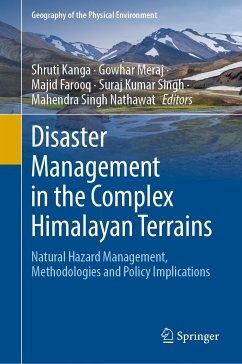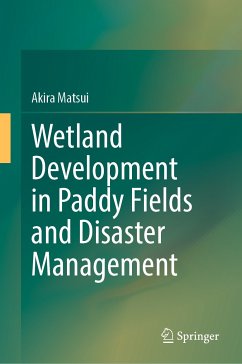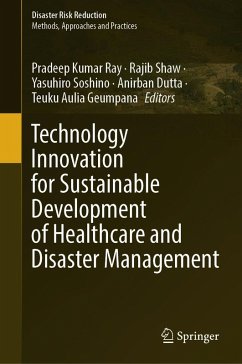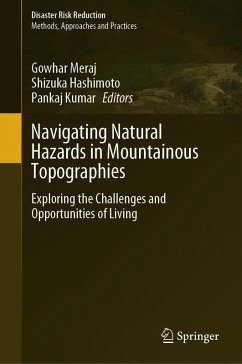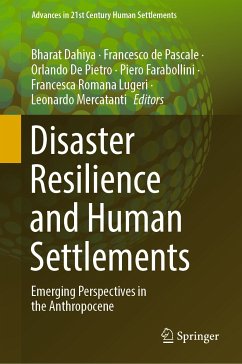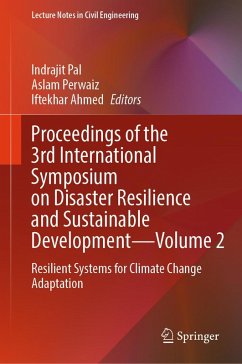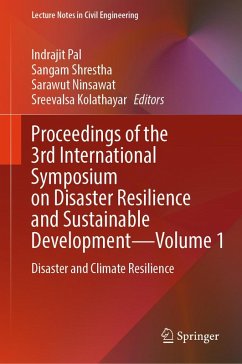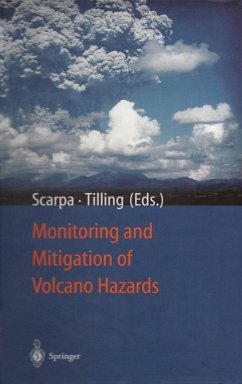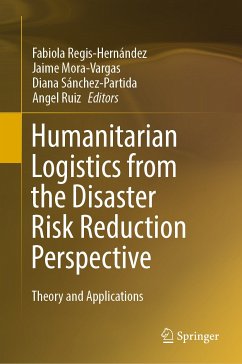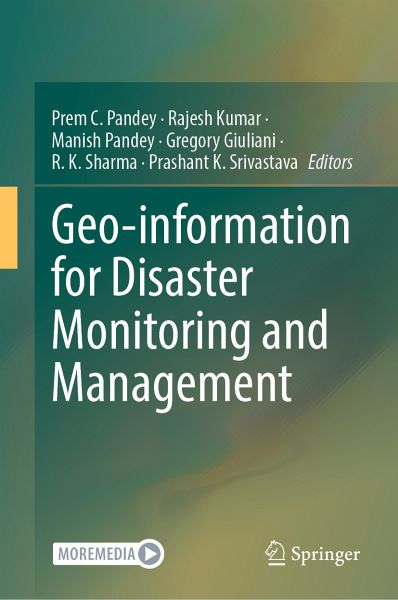
eBook, PDF
Geo-information for Disaster Monitoring and Management (eBook, PDF)

PAYBACK Punkte
52 °P sammeln!





The objective of this publication is to provide insight into advancing remote sensing techniques dealing with floods, droughts, landslides, earthquakes, permafrost-related hazards, glacial lake outburst floods, forest fires, droughts, tropical cyclones, climate resilience and COVID-19. This publication will incorporate the latest technologies and techniques to illustrate disaster monitoring for acquiring information and dissemination of technological results and outcomes for the betterment of society. This publication would be of immense importance for earth scientists, policymakers and profes...
The objective of this publication is to provide insight into advancing remote sensing techniques dealing with floods, droughts, landslides, earthquakes, permafrost-related hazards, glacial lake outburst floods, forest fires, droughts, tropical cyclones, climate resilience and COVID-19. This publication will incorporate the latest technologies and techniques to illustrate disaster monitoring for acquiring information and dissemination of technological results and outcomes for the betterment of society. This publication would be of immense importance for earth scientists, policymakers and professionals working in the field of disaster risk reduction.
Dieser Download kann aus rechtlichen Gründen nur mit Rechnungsadresse in A, B, BG, CY, CZ, D, DK, EW, E, FIN, F, GR, HR, H, IRL, I, LT, L, LR, M, NL, PL, P, R, S, SLO, SK ausgeliefert werden.
- Geräte: PC
- ohne Kopierschutz
- eBook Hilfe
- Größe: 23.35MB
- Text-to-Speech
- E-Mail des Verlags für Barrierefreiheitsfragen: accessibilitysupport@springernature.com
- Alle Inhalte über Screenreader oder taktile Geräte zugänglich
- Navigation über vor-/zurück-Elemente ohne Inhaltsverzeichnis
- Hoher Kontrast zwischen Text und Hintergrund (min. 4.5 =>1)
- Inhalte verständlich ohne Farbwahrnehmung
- Kurze Alternativtexte für nicht-textuelle Inhalte vorhanden
- Text und Medien in logischer Lesereihenfolge angeordnet
- Navigierbares Inhaltsverzeichnis für direkten Zugriff auf Text und Medien
- Keine Einschränkung der Vorlesefunktionen, außer bei spezifischen Ausnahmen
>55 peer reviewed journal articles, 7 Edited Books, several book chapters and presented his work in several conferences. Additionally, he is also a member of Indian Society of Geomatics, Indian Society of Remote Sensing, IUCN-CEM, SPIE and AAG. He is also acting as editorial Board members of Geocarto International (T & F), Sustainable Development WILEY (IF 12.5), and serving as Guest editor for Remote Sensing, MDPI. He is having an expertise in remote sensing of environment research themes: his research interests include natural resource including forestry, agricultural, urban studies and environmental pollutant modeling. Dr. Rajesh Kumar successfully defended his Ph.D. (Geography) on 'Fluvial Processes in Lower Rapti River Basin: A Case Study of Impacts on Arable Land' from the CSRD, JNU in 2011. He was awarded Junior Research Fellowship (JRF) in 2009 by the University Grant Commission (UGC), New Delhi. He worked as Research Associate in the Ministry of Environment, Forest and Climate Change (MoEFCC), Govt. of India (GoI)- sponsored project on 'Ganga River Basin Management Plan' in collaboration with School of Environmental Sciences, JNU and IIT Kanpur during October 2011 -July 2013. Further, he joined the CSRD as Research Associate and worked in the Departmentof Science (DST), GoI-sponsored project on 'Geomorphological and Chronostratigraphic Reconstruction of Glacial Episodes of Gangotri Glacier in Bhagirathi Basin, NW Garhwal Himalaya' from August 2013 to August 2014. He is actively involved in research and wrote 16 research papers/book chapters/Atlas, published by national and international publishers. His major research areas are related to applications of geospatial technology in river science. His research papers are related to the anthropocene epoch of geological time scale dealing with the impact of human activities on rivers and climate-related disasters. Dr. Manish Pandey currently works at the University Center for Research & Development (UCRD), Chandigarh University located in Mohali, Punjab, India. He earned his graduation (Geography honors) and post-graduation (geography) from University of Allahabad, located in Allahabad, Uttar Pradesh, India. He has been awarded research grant as Junior Research Fellow (JRF) and Senior Research Fellow (SRF) for carrying out his doctoral research by the Council of Scientific and Industrial Research (CSIR), Ministry of Human Resource Development, Government of India. After earning his Ph.D. degree in the field of geomorphology, he has been engaged in post-doctoral research (at different research positions) for more than 5 years. His research interests are in Geography, Fluvial and Glacial Geomorphology, Glaciology and Remote Sensing & Geoinformatics (GIS). His simple interest is in understanding the process-form relationship in diverse environmental settings. He is an experienced research associate with a demonstrated capability of working in the research industry, skilled in cartography, geomorphology, well versed in GIS packages like ArcGIS, QGIS, ERDAS Imagine, and Data Analysis, and Strong research professional with a Doctor of Philosophy (Ph.D.) in Fluvial Geomorphology from Banaras Hindu University. His exposure to glaciological field work and training by India's elite government institutions like the Geological Survey of India, and geospatial trainings provided to him by institutions like ISRO has infused some very important skills in the respected fields of research needed to carry out this project to finality. Dr. Manish has been in the field training groups carrying out research in the study of the Himalayan Foreland Basin deposits, ancient Neogene Siwalik sequences and their modern analogues like Gangetic Foreland Basin sediments facies to understand the role of synsedimentary processes in the evolution of this world's one of the important foreland basin system on the planet. Dr. Gregory Giuliani is the Head of the Digital Earth Unit and Swiss Data Cube Project Leader at GRID-Geneva of the United Nations Environment Programme (UNEP) and a Senior Lecturer at the University of Geneva's Institute for Environmental Sciences. Gregory Giuliani, a Senior Lecturer at the University of Genevais a geologist and environmental scientist who specializes in Geographical Information Systems (GIS) analyses and Spatial Data Infrastructures (SDI). He has been also working at GRID-Geneva of the United Nations Environment Programme (UNEP) since 2001, where he was previously the focal point for Spatial Data Infrastructure (SDI) and is currently the Head of the Digital Earth Unit. Gregory's research focuses on Land Change Science and how Earth observations can be used to monitor and assess environmental changes and support sustainable development. He holds a BSc in Earth Sciences and an MSc and PhD in Environmental Sciences. Gregory's research focuses on Land Change Science and how Earth observations can be used to monitor and assess environmental changes and support sustainable development. Interdisciplinary is a key element for generating new ideas and innovations in his research. Interdisciplinary is a key element for generating new ideas and innovations in his research. He also previously worked as a GIS Consultant for the World Health Organization, as a University tutor in remote sensing and GIS and as a GIS developer in a local Swiss GIS company. Dr. R.K. Sharma is a Glacio-hydrologist working on glacier dynamics and potentially vulnerable glacial lakes in Sikkim Himalaya. He is the Co-Principal Investigator of a nationally coordinated project entitled "National Mission for Sustaining the Himalayan Ecosystem (NMSHE) Phase II" for the state of Sikkim in collaboration with the Department of Science and Technology Government of India. His current research interest lies in in-situ-based monitoring of glaciers, remote sensing and scientific assessment of the probability of glacial lake outburst floods (GLOFs), glacial lake management and GLOF hazard mitigation in the Himalaya. He serves in the Sikkim State Council of Science and Technology, Vigyan Bhawan, Government of Sikkim located in the capital city of Gangtok, Sikkim, India and has research experience of more than ten years in Sikkim Himalaya. He has published many scientific research papers in Scopus-Indexed Journals in the field of climate change and forest fires, glacier hydrology, suspended sediment transfer from the Glacial stream, glacial lake outburst floods, etc. Recently, he has developed a glacial lake volume-area empirical equation for the Indian Himalayan moraine-dammed glacial lakes Dr. Prashant K. Srivastava is working at IESD, Banaras Hindu University as a faculty and was affiliated with Hydrological Sciences, NASA Goddard Space Flight Center as research scientist on SMAP satellite soil moisture retrieval algorithm development, instrumentation and simulation for various applications. He received his PhD degree from Department of Civil Engineering, University of Bristol, Bristol, UK. Prashant was the recipient of several awards such as NASA Fellowship; USA; University of Maryland Fellowship, USA; Commonwealth Fellowship, U.K.; Early Career Research Award (ECRA, DST, India), CSIR as well as UGC- JRF-NET (2005, 2006). He is leading number of projects funded from reputed agencies in India as well as world. He is also a collaborator with NASA JPL on SMAP soil moisture calibration and validation as well as Scatsat-1, NISAR, AVIRIS-NG missions of India. Prashant made 140+ publications in peer-reviewed journals and published 7 books with reputed publishing house such as Springer, Taylor and Francis, AGU-Wiley and Elsevier and several book chapters (100+) with good citation index. He presented his work in several conferences and workshop and acting as convener for last few years in EGU, Hydroinformatics (HIC) and other conferences. He is also acting as Associate Editor of Journal of Hydrology, Associate Editor of Hydrological Sciences Journal, Associate Editor of Remote Sensing (MDPI), Associate Editor of Journal of Earth System Science, Associate Editor of Environment, Development and Sustainability, Editor of Environmental Processes, Associate Editor of Cogent Environmental Sciences, Co-editor-in-Chief Bulletin of Environmental and Scientific Research, Guest Editor Physics and Chemistry of the Earth (Elsevier), IJSLUP and JSRS.
Produktdetails
- Verlag: Springer Nature Switzerland
- Seitenzahl: 517
- Erscheinungstermin: 22. Mai 2024
- Englisch
- ISBN-13: 9783031510533
- Artikelnr.: 70750030
Für dieses Produkt wurde noch keine Bewertung abgegeben. Wir würden uns sehr freuen, wenn du die erste Bewertung schreibst!
Eine Bewertung schreiben
Eine Bewertung schreiben
Andere Kunden interessierten sich für


